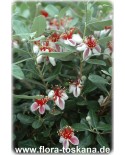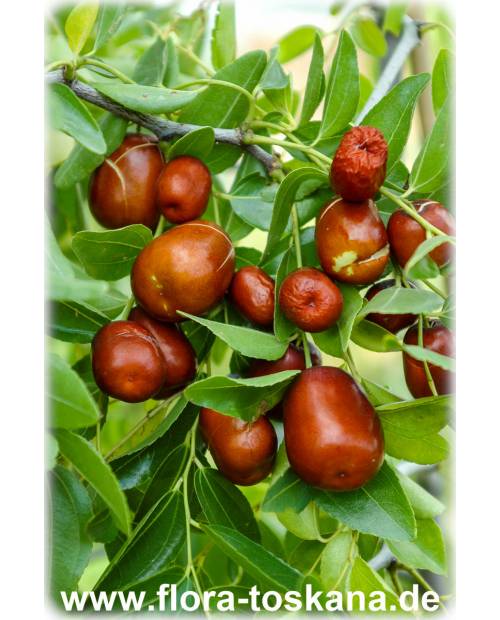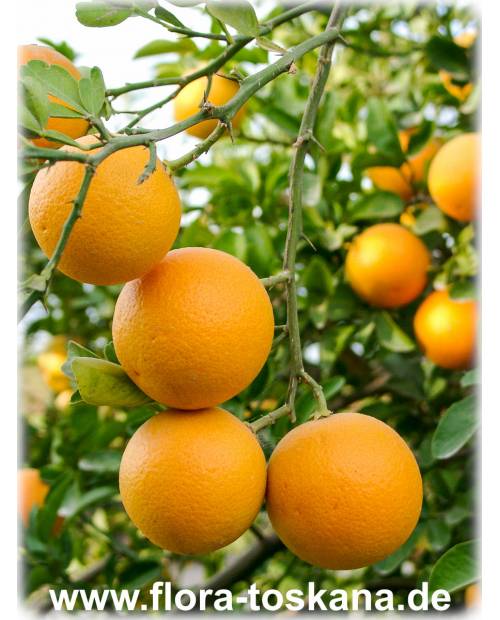Acca sellowiana - Feijoa, Pinapple Guava, Guavasteen
The evergreen Brazilian Guava, also known as Feijoa or Pineapple Guava (Acca sellowiana), produces large, attractive, showy red and white flowers followed by juicy, exotic and tasty fruits. Thanks to their robustness and adaptability, the evergreen shrubs are an easy-care all-round package for every conservatory, garden and pot garden.
The Pineapple Guava (Acca sellowiana), also known as Feijoa, blooms profusely in May or June with eye-catching flowers with a size of 2.5 to 3 cm. The exotic flowers consist of firm, white sepals and petals with a dense bunch of red stamens in the center. The petals are edible and taste sweet. In New Zealand, the world’s leader in cultivating Pineapple Guava, also birds love to eat them. The flowers are self-pollinating, so one plant is sufficient for pollination and fruit set. However, the yield can be increased by adding a second plant. Fruits differ very much in shape from oblong-oval and pear-shaped to round. Even when fully ripe, the fruit's skin stays bluish-green. The fruit's aroma and fragrance are unique, the white pulp is slightly gritty, juicy and sweet. The taste is similar to guava, pineapple or strawberry, hence the name Pineapple Guava. After ripening 18 to 24 weeks the fruits can be harvested in fall. Grafted varieties like ‘Triumph’ or ‘Mammouth’ guarantee high quality fruits and a rich harvest even from young plants. These varieties can be found here on our fruit varieties page. With their gray and entire leaves, Pineapple Guava is attractive throughout the year and despite its South American origin fits well into Mediterranean designs for terraces or conservatories. Pineapple Guavas will normally have no problems with insect pests when in a sunny place with sufficient water supply. They tolerate heat as well as wind. In nature, it grows as a multi-stemmed shrub. It can be easily pruned into shape as a standard or half-standard tree or kept in shape by rigorous pruning in March. Pineapple Guava is a rather hardy plant and can be placed outside early in the year and remain there until October/November.
![]() Quality: attractive red-white fluffy flowers with edible petals; delicious fruit; evergreen; compact growth; robust and easy to care for; very tolerant to pruning
Quality: attractive red-white fluffy flowers with edible petals; delicious fruit; evergreen; compact growth; robust and easy to care for; very tolerant to pruning![]() Use: in pots from April to October/November outdoors on balcony, terrace and in the garden with overwintering in an unheated winter quarter; all year round in unheated or heated conservatories; possibly planted into the garden
Use: in pots from April to October/November outdoors on balcony, terrace and in the garden with overwintering in an unheated winter quarter; all year round in unheated or heated conservatories; possibly planted into the garden
Data sheet
- Family
- Myrtaceae
- Origin
- South Amercia
- Flowering period
- Spring
- Color of flowers
- Red
- Fruits
- Edible fruits
- Growth
- Shrub
- Location
- Full sun
- winter temperature
- 10 (±10)°C
- Minimum temperature
- -10 °C
- Hardiness Zones
- 8
- Height
- 2,5 - 3 m
You might also like
Customers who bought this product also bought:













































